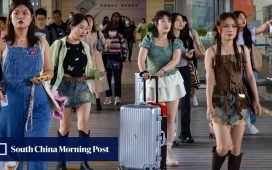Of the 52 lots offered for sale, 49 found buyers – a sell-through rate of 94 per cent – who paid a combined HK$673.4 million (US$86 million). Six works were withdrawn from the Modern & Contemporary section of the sale and two from the Now section before the auction.
Pablo Picasso’s Le Peintre (1963), heavily promoted before the auction, was sold at a hammer price of HK$66 million, equalling the lowest presale estimate. The lot was guaranteed by an irrevocable bid. Including commission, the auction price was HK$78.7 million.

As data from research firm ArtTactic shows, global sales of artworks produced after 2000 fell 17 per cent in 2023 from a year earlier, but this market segment remains more resilient than that for older artworks, which fell 22 per cent in the same period.

The top result in the Now section was achieved by George Condo’s Green Eyed Lady (2016), which sold for HK$13.5 million and was also backed by an irrevocable bid.
Although the majority of lots sold achieved prices squarely in the middle of their estimates, total sales were only 61 per cent of the HK$1.1 billion tally for Sotheby’s modern and contemporary art evening sales in April 2023.

Richard Zhang Teng, an art economist in Shanghai, says the early spring sale results this year suggest there is cautious optimism in the market.
“Compared to last year’s 50th anniversary sales in Hong Kong, which were jam-packed with a wider selection of works and more blue-chip names, this year’s auction reflects a more conservative approach from both buyers and the auction house. But with Sotheby’s lower commission fees, the results were quite positive given the market conditions,” says Zhang.
Zhang, founder of research firm Economics on Art Market, says the market is unlikely to recover in the near future, citing the International Monetary Fund’s February prediction of a potential 30-60 per cent decline in China’s real estate investment compared to 2022 levels.
“The art market is a very passive market. It can’t simply improve through self-adjustment; it’s always subject to the volatility of the broader macroeconomic situation,” he says.













